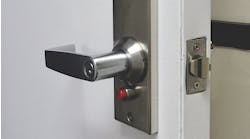Threats and potential dangers can be found in most neighborhoods throughout the nation. The public schools in those neighborhoods are not immune from the risks that exist beyond its walls. Schools must be vigilant to guard against possible child abductions, sexual assaults, theft and vandalism.
Allowing the appropriate people — students, teachers, staff, parent volunteers and vendors — campus access, while keeping the inappropriate people — sexual predators, kidnappers, thieves and vandals — out is a challenge that faces virtually all school and university administrators. Every school needs a visitor-management plan that is well-written, well-rehearsed and well-enforced as one of the first steps in protecting people and property.
Alert to danger
School administrators no longer can pretend that their facilities are safe havens from the troubles that occur in society.
Go to the U.S. Department of Justice's online national sex offender public registry, pick a major city, and select a neighborhood. Anywhere from a few to 40 or more registered sex offenders are likely to be within walking distance of the neighborhood's public elementary school.
According to the National Alert Registry, about 500,000 registered sex offenders live in the United States, and that includes only those that have been arrested and convicted. There is no reliable count of the number of potential pedophiles. There also is no way to measure how many of these people come onto school campuses each day.
More than 700 child abductions are reported in the nation each day, according to the National Center for Missing and Exploited Children. Most are taken by a relative — often a parent who has been served with a temporary restraining order during or after a divorce. Children frequently are taken from school, where someone staffing the front desk may be unaware of a court order.
Campus thefts are commonplace. On many campuses, it is easy to visit during the day and check out which rooms contain the most valuable and sellable equipment, such as computers, printers and televisions. Many times, a person carrying a stolen computer can walk off campus unchallenged — even during regular school hours.
Fires, broken windows, graffiti, super-glued door locks and other acts of vandalism cause interruptions in a child's education. It costs education institutions across the nation hundreds of millions of dollars each year to repair the damage caused by vandals.
The basics
A visitor-management plan should include basic policies and procedures, which generally are inexpensive and easy to carry out. Other simple, low-tech steps can add another level of protection. Electronic security solutions offer a higher level of protection that many schools can afford.
In a basic visitor-management plan, a school should:
-
Limit the number of campus entries. Many schools allow students (and who knows who else) to enter the campus from multiple points. Elementary schools, in particular, should have one entry into the campus for students, parents and other visitors. High school campuses should limit access to only a few entries. While classes are in session, those entries should be closed and locked to outsiders. Open the entry 30 minutes before the start of school, and close it 30 minutes after the last classes.
-
Assign school resource officers or administrative staff to each access point immediately before and after school and during lunch (if students are permitted to leave campus) to monitor who enters the campus. Allow only known students and volunteers to enter. Send all other visitors to the office. It is critical that during school hours school administrators or school resource officers walk around the exterior to verify that the doors are closed and secured properly.
-
Require all teachers and staff to wear a photo ID badge at all times while on the school grounds. Badges can be issued as employees are hired. This also makes it easier for younger children to spot someone they can trust in an emergency.
-
Require that all parents, volunteers, vendors and other visitors register in the office. All visitors should show a state-issued identification card, provide a home telephone number, state a reason for being on campus, and note their time of arrival. A school staff member should provide a temporary identification badge that must be worn at all times on campus. Visitors should check out when leaving and return the badge. Regular volunteers can be issued a photo ID badge through the institution.
-
Instruct all teachers and staff members to immediately challenge any adult walking about the campus without an identification badge. If the person refuses to leave, local law enforcement should be summoned.
-
Make a written record of the school's visitor-management plan, and give a copy to every teacher and staff member. Discuss and practice the plan regularly, such as before the start of a school year. Also, plan on reviewing the plan a couple of times during the year.
Each of these steps requires little expense at the campus level beyond a registration book, a pen and adhesive labels.
A step beyond
Low-tech security steps can help control access to a campus. Fencing, gates and locks can close off many potential entries and guide visitors to the correct entry points. Also, signage can help direct people to the correct entrances and provide information such as office hours and the proper credentials needed to gain access to a campus.
Basic electronic security products add a higher measure of security. Intercom systems allow visitors to communicate with office personnel while still outside the school. Many systems also come equipped with cameras that enable the school staff not only to hear, but also to see who wants access. The cameras also enable the school to capture and store a picture of a visitor — even those denied entry for a lack of identification or other reasons. Video intercoms also are useful for remotely permitting access to vendors and contractors requiring entry to cafeterias, loading docks, storage buildings and gyms.
Some visitor-management systems can capture a digital photo of the person, as well as a digital image and details of the individual's identification, such as a driver's license, passport or business card. That information can be compared against the national sex offender registry or other federal and state crime databases. A check of this type takes only a few seconds. These systems also can take a visitor's picture and print a temporary photo ID badge in less than a minute. This extra level of security makes it more difficult for someone to check into the office and then give a visitor's pass to another person.
It also is simple to program other information, such as temporary restraining orders, into the system. This will help prevent a non-custodial parent from removing a child from the school without permission. The systems record the exact date and time of a person's arrival and departure from the office, creating a tracking mechanism of the individual's activities. It also is possible to add a fingerprint reader or other biometric hardware to automatically detect frequent visitors or employees, allowing them to obtain a pass in less than 10 seconds.
Fiel Sr. is the public-safety adviser specializing in education for ADT Security Services, Inc., Alexandria, Va. For six years, he was executive director of school security of Washington, D.C., Public Schools, where he managed 163 campuses.

